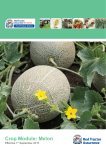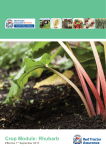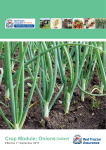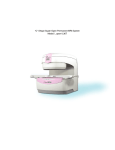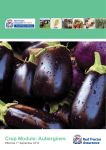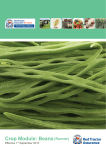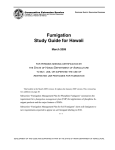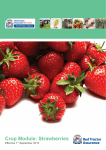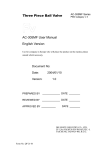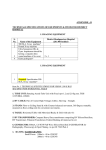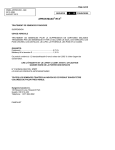Download Crop Module: Asparagus - Red Tractor Assurance
Transcript
Crop Module: Asparagus Effective 1st September 2015 Welcome T his crop specific module for asparagus has been written to complement and avoid duplicating the generic principles of the Red Tractor Farm Assurance Fresh Produce Scheme standards. It is advisable to read the Red Tractor Farm Assurance Fresh Produce standards before reading this crop specific module. This module is designed to stimulate thought in the mind of the reader. It contains crop specific guidance and standards, where applicable, in addition to the requirements stated in the generic Fresh Produce standards. Within this module the important requirements outlined in the crop specific standards section will be verified during the Red Tractor Farm Assurance assessment and compliance will form a part of the certification/approval decision. Disclaimer and trade mark acknowledgement Although every effort has been made to ensure accuracy, Assured Food Standards does not accept any responsibility for errors and omissions. Trade names are only used in this module where use of that specific product is essential. All such products are annotated® and all trademark rights are hereby acknowledged. Notes: Pesticide Information General Introduction Following a systematic approach will help growers identify and manage the risks involved in crop production. This module is based on a typical crop production process and food safety, health & safety, environmental and quality hazards are identified. Appropriate controls may then be established to minimise risk. Food safety and health & safety issues always take precedent over quality and environmental controls. The layout of this module follows the same structure as that used in the Red Tractor Farm Assurance Fresh Produce Standards. The content of the module is reviewed prior to the issue of updated editions. The review process considers both new developments and all relevant technology which has emerged since the last review was completed and which have been found to be both workable by the grower and beneficial to the environment. The aim is to transfer such information and technologies to growers. Acknowledgements Red Tractor Farm Assurance Fresh Produce gratefully acknowledges the contribution of all consultees in the preparation of this protocol, particularly members of the Asparagus Growers Association and Wilson Dyer previously with ADAS and now an independent Asparagus Consultant. The Red Tractor Fresh Produce team has been working with Fera to provide tailored access to the LIAISON database for all Red Tractor Fresh Produce members. This system allows individual growers access to all information for plant protection products approved for use under the Red Tractor Fresh Produce Scheme. LIAISON can be accessed under the Produce tab via the “Checkers and Services” page where you will also find a user manual. Searches will be filtered specifically for the crops for which you are registered. Once you have logged onto the site and clicked on the LIAISON hyperlink you will be directed to the LIAISON home screen. You will need a username and password and these will be sent once you have registered: http://assurance.redtractor.org.uk/rtassurance/ services/Registration/members.eb . Front cover image credit: British Growers Association Ltd. 1 Red Tractor Assurance for Farms – Crop-specific Module: Asparagus © Assured Food Standards 2015 Content Contents ADDITIONAL REQUIREMENTS AGAINST CURRENT STANDARDS 02 CROP SPECIFIC STANDARDS02 CHOICE OF VARIETY OR ROOTSTOCK AND PLANT HEALTH CERTIFICATION 03 SITE AND SOIL MANAGEMENT 03 ENVIRONMENTAL PROTECTION AND CONTAMINATION CONTROL04 IRRIGATION 08 HARVEST AND STORAGE 08 RESIDUES AND CONTAMINANTS 09 APPENDIX 1: S OIL STERILANTS CURRENTLY APPROVED FOR USE PRE-PLANTING10 APPENDIX 2: FERTILISER RECOMMENDATIONS11 ADDITIONAL REQUIREMENTS AGAINST CURRENT STANDARDS None for this crop module CROP SPECIFIC STANDARDS STANDARDS HOW YOU WILL BE MEASURED RECORDS (to be kept for 2 years) CQ.42.a The asparagus washing area must be separated from the packing area so that clean and dirty areas are distinct Red Tractor Assurance for Farms – Crop-specific Module: Asparagus © Assured Food Standards 2015 2 GUIDANCE CHOICE OF VARIETY OR ROOTSTOCK AND PLANT HEALTH CERTIFICATION STANDARD OF PROPAGATED MATERIAL BUYING IN PLANTS Growers should visit their propagators to inspect their plants prior to delivery. Most nurseries now buy plants in from external propagators and it is important to ensure that the propagator complies with the requirements set out. Growers should formalise the supply contract with their propagators and agree to the various standards required, stipulating the pesticides that can be used and the size of plant at delivery etc. Growers should ensure their supplier adheres to their contractual requirements by requesting records of plant treatments and visiting to inspect plants before delivery. In all cases avoid soils which are poorly drained or with a high water table. Waterlogging in winter increases the spread of soil borne diseases particularly Fusarium wilt (Fusarium oxysporum f. sp. asparagi) and Phytophthora crown and spear rot (Phytophthora megasperma). Waterlogging in itself provides anaerobic conditions unsuitable for asparagus roots and is likely to cause significant root death. This problem can be overcome on many sites with adequate field drainage. Some sandy soils are prone to slumping and compaction after wet weather and also after the long harvesting season (up to 2 months) when the crop could have been walked through up to fifty times. It is recommended that for the benefit of both parties, plants should be carefully inspected on delivery and any concerns/complaints notified immediately to the propagator. Pesticide application records should also be checked to ensure there will be no conflicts with biological control used in cropping. The window for soil cultivations in an established crop is very narrow and on heavier soils care should be taken to make optimum use of this window i.e. when soil moisture conditions are ideal for operations such as fern removal in the autumn or winter and soil ridging over the crowns in autumn, winter or spring. Cultivations in dry conditions can result in slumping or capping of the soil surface if rainfall occurs soon afterwards. Soil smearing and compaction can occur if cultivation is carried out on wet soils. E. coli and food poisoning Site History The risks from food poisoning organisms in this crop are minimal but both the propagator and the grower should be aware of the risks from contamination with animal manures and dirty water. See generic protocol for further details. Previous cropping should be considered when siting new plantations of asparagus. SITE AND SOIL MANAGEMENT Sites which are not prone to frost and are well sheltered from wind are preferred for asparagus production. Frost will damage the new spear growth in the spring which can result in the crop being out of production for up to seven days and also cause premature fern death in the autumn. Winds can damage the crop in two ways by: a) bending spears during the harvesting season with a consequential loss in quality; and b) breaking fern growth later in the year resulting in a loss of photosynthetic potential. 3 Very heavy clay soils are generally unsuitable due to poor aeration and drainage problems. Where carrots, potatoes and parsnips have been grown there is always the risk that violet root rot (Helicobasidium purpureum) may have infected these crops. Asparagus can be affected by violet root rot. Similarly if infected waste root crops that have been fed to cattle, the disease can pass through the animal’s alimentary system. Any resulting manure will then be infected and if spread prior to planting asparagus can cause problems later. Sites known to be affected with violet root rot should be avoided. Planting crowns or container raised transplants are accepted as the most satisfactory ways of successfully establishing asparagus crops. Direct drilling of the crop where it is to be grown for a number of years is not recommended. Ideally sites should be flat to avoid soil erosion or should be on a slight south facing slope. Rotations A wide range of soils are suitable for asparagus growing including loamy sand, sandy loam, loam, silty loam, sandy silt loam, silt, sandy clay loam and silty clay loam. It is best to rotate asparagus crops to prevent the buildup of disease problems such as Fusarium wilt and Phytophthora crown and spear rot. Successfully grown crops should produce economic yields for about 15 years. Red Tractor Assurance for Farms – Crop-specific Module: Asparagus © Assured Food Standards 2015 After removal of the crop, toxins will remain in the soil for some years and replanting should not be contemplated for at least 10 years. Soil Sterilisation Soil sterilisation has rarely been necessary to date as asparagus growers are generally able to utilise land virgin to asparagus. In the future, some growers may find it necessary to re-establish on previously cropped asparagus land. Soil should only be sterilised when there is a known disease risk present. Do not sterilise solely for purposes of weed seed elimination. Formaldehyde, dazomet, metam sodium and steam are currently approved for soil sterilising prior to planting asparagus, but are unlikely to give complete control of Fusarium and other pathogens which may be deep in the soil profile, and priority should be given to finding clean sites. The use of methyl bromide has been forbidden since 1 January 2005. Fuller details are given in the Appendix. With improved application methods other sterilants such as metam sodium and formalin may prove to be perfectly adequate. Therefore growers should assume the responsibility of keeping in touch with new developments, through conferences, workshops and regular contact with advisors. Before using sterilants, carry out a COSHH assessment as required by law. Consider the risk to the environment, the operator and the subsequent crop. Carry out a cress germination test if required prior to planting. Post harvest plantation maintenance At the termination of the harvesting period (generally accepted to be around 21st of June) the crop should be given every opportunity to produce vigorous, good quality fern growth free of pests and diseases and with good control of annual and perennial weeds. With the onset of frost in the autumn fern growth will be harmed. Dead fern should be removed from the plantation and preferably burnt off site, but great care should be taken not to damage soil structure by going on the site in wet conditions. ENVIRONMENTAL PROTECTION & CONTAMINATION CONTROL PEST CONTROL The guiding principle is that pesticide inputs should be minimised through prevention rather than cure. An integrated approach should be adopted to achieve this involving the following management steps. Good management and planning: a. Careful site selection to avoid potential or previous pest problems thereby enhancing plant health b. Sensible crop rotations to avoid build-up of problems. Cultural preventative techniques: a. Good crop and field hygiene, including good weed control b. Promoting crop health by maximising nutrient availability through soil analysis and accurate application to avoid excess. Corrective action: If the above fail to prevent or control the pests, the following approach should be adopted: a. Establish the need to take corrective action by regular monitoring and referring to thresholds (where established). The effect of prevailing weather conditions should also be considered b. Where corrective action is required, biological and natural methods of pest and disease control, if available, should be considered first c. If chemical control is needed, the following points should be considered, whilst ensuring effective control is achieved n Use the least toxic and persistent product with due respect to its ecotoxicity. n Use the product most selective to biological control agents and naturally occurring beneficial organisms. n Use the minimum effective dose rate. n Use appropriate application methods with effectively maintained equipment, and spot treating wherever possible. n All spray applications should be targeted to the times of maximum effectiveness in controlling pests, diseases and weeds. APPROVED USES NOT INCLUDED ON THE PRODUCT LABEL In many circumstances, particularly for minor crops, product labels do not include all of the approved uses and growers wishing to check the approval notice of a particular product should note that this information is available using the LIAISON® search accessible via their Red Tractor Farm Assurance home page after logging in. Red Tractor Assurance for Farms – Crop-specific Module: Asparagus © Assured Food Standards 2015 4 A search on the Extensions of Authorisation for Minor Use page of LIAISON® by crop or product name should yield a results page. A click on the product name should link to a summary of the approval information. Near the bottom of the summary is the specific off-label number (e.g. 2920/09) and this link will open up a pdf of the current EAMU document giving details of the extension of use. Cultural Control Site selection If direct drilling a crop avoid drilling on sites previously in long term grass leys which are likely to have a high wireworm population. If possible avoid sites adjacent to large areas of wasteland or woodland where asparagus beetle may hibernate, or damp areas and weedy headlands where slugs may survive and feed. Trash removal Careful and thorough trash removal is mainly practised for the control of fungal diseases. However, levels of asparagus beetle (Crioseris asparagi) and slugs may be reduced by removing their over-wintering habitat if trash is removed from the crop during the dormant period. Integrated control Integrated control of pests on asparagus includes cultural and chemical control. Regular crop monitoring is essential. This should be carried out either by trained farm staff or a qualified adviser at least fortnightly during the growing season for slugs, asparagus beetle and aphids (weekly during hot weather). Monitoring for slugs using tiles and slug bait is recommended. Biological control At the present time no biological control measures have been developed for use on asparagus crops. However, progress on the use of biological control organisms is rapid and it is the responsibility of all growers to remain in touch with these developments and make use of new biological control organisms within an overall integrated pest management system. Chemical control Chemical control is acceptable provided it is used as part of an integrated pest and disease management programme with cultural and biological methods (when available). Regular monitoring of asparagus crops should 5 be undertaken at least fortnightly through the growing season and a written record kept of all observations and any subsequent recommendations. Insecticides should not be applied prophylactically to asparagus crops. The presence of a pest should first be established and due regard then given to the procedures laid down in the section Good Management and Planning. Approved insecticides currently recommended for specific pests are: Aphids - fatty acid (EAMU) Asparagus beetle - cypermethrin (EAMU), *pyrethrins, thiacloprid (EAMU) Bird and animal repellents - *aluminium ammonium phosphate Slugs - *copper sillicate, *ferric phosphate,*metaldehyde * These insecticides have an approval for Crops General / Vegetable Crops, which are not specific to asparagus. NB: There are other materials available that can be used on asparagus and they include maltodextrin, carbonic acid diamba/urea, citrus fruit extract/garlic, dodecylphenol ethoxylate, garlic and natural plant extracts. However, there is very little experience of their effectiveness on asparagus crops. DISEASES The guiding principle is that fungicide inputs should be minimised through prevention rather than cure. An integrated approach should be adopted in order to achieve this involving the following management steps. Good management and planning: Careful site selection to avoid known potential or previous problems thereby enhancing plant health, sensible crop rotations to avoid build-up of problems and inclusion of resistant varieties (where applicable) in cropping programmes whilst respecting the need to meet the required quality parameters and eating requirements. Cultural preventative techniques: Good crop and field hygiene, maximising nutrient availability to promote crop health through soil analysis and accurate nutrient applications to avoid excess. Red Tractor Assurance for Farms – Crop-specific Module: Asparagus © Assured Food Standards 2015 Corrective action: Rotations If the above fail to prevent or control the situation, the following approach should be adopted: Soil borne diseases such as Fusarium wilt and Phytophthora crown and spear rot are less likely to build up to damaging levels if clean land is used. a. Establish the need to take corrective action by regular monitoring and referring to thresholds (where established). The effect of prevailing weather conditions should also be considered b. Where corrective action is required, biological and natural methods (if available) of pest and disease control should be considered first c. If chemical control is needed, the following points should be considered, whilst ensuring effective control is achieved: n Use of the least toxic and persistent product. n Use of the most selective product to reduce the impact on naturally occurring beneficial organisms. n Using appropriate application methods with effectively maintained equipment, and spot treating wherever possible. Trash removal and soil incorporation Removal of trash, i.e. dead fern growth during late autumn, is a very effective hygiene measure to reduce the levels of inoculum, especially of purple spot (Stemphylium). Any trash remaining on the surface needs to be thoroughly incorporated into the soil during the ridging operations. Burying trash infected with Stemphylium spores has the effect of inactivating the spores, which prevents the spread of the disease onto the new spear growth in the following spring. Integrated control Integrated controls of diseases on asparagus are limited and include cultural and chemical control. Regular crop monitoring is essential. There are several important guidelines which should be adhered to: Cultural control i. Only use healthy planting material. Plants showing obvious signs of disease should be rejected. Site selection ii. There are currently no biological control methods available for fungal diseases. However cultural controls should be carefully observed. Do not plant on soils known to have high levels of soilborne disease inoculum present such as fusarium wilt. Avoid planting on very heavy or poorly drained soils especially those prone to waterlogging during the winter months. The presence of free water increases the spread of Phytophthora diseases. Avoid planting on frost prone sites or very exposed sites. Frost and/or wind damage provide entry points for fungal spores. Avoid planting on sites surrounded by very high hedges or woodlands or on sites in low lying areas. Each of these factors can encourage high humidities under certain conditions when diseases such as purple spot (Stemphylium vesicarium) can develop. Avoid sites that have grown carrots, potatoes and parsnips known to have been infected with violet root rot (Helicobasidium purpureum). Avoid sites with soils that will dry out very quickly with consequential increase in plant stress which will encourage diseases such as Fusarium wilt (Fusarium oxysporum f. sp. asparagi). iii. The diseases that seriously infect asparagus are limited, e.g.Fusarium wilt, Phytophthora crown and spear rot, purple spot and violet root rot. Rust is seldom a serious problem on UK crops although the disease was reported on several crops in 1997. Some diseases require prophylactic fungicide treatments in order to aid control. Other fungal diseases only require fungicide treatments after the disease has been observed in the crop. iv. Before applying fungicides ensure that you use the product which is safest to the environment and natural predators as well as being efficacious for the particular disease concerned. v. The use of salt (sodium chloride) has been used successfully to control Fusarium wilt in the USA. Trials in the UK conducted over a 7 year period have shown minimal yield responses after the application of salt. Salt appears to slow down decline in asparagus crops. Red Tractor Assurance for Farms – Crop-specific Module: Asparagus © Assured Food Standards 2015 6 Chemical control Consider the guidelines laid down in sections Good Management and Planning and Integrated Control. Chemicals should only be used as part of an integrated pest and disease management programme. Regular monitoring of asparagus crops should be undertaken at least fortnightly during the growing season and a written record should be kept of observations made and subsequent recommendations. If a product is to be used under the term of an existing EAMU the relevant ‘notice of approval’ should be obtained and read before applying the product. At all other times abide by all label instruction. APPROVED FUNGICIDES CURRENTLY RECOMMENDED FOR SPECIFIC DISEASES ARE: Botritis-bacillus subtilis (EAMU), boscalid/pyraclostrobin (EAMU), cyprodinil/fludioxonil (EAMU) Stemphylium - azoxystrobin, azoxystrobin/chlorothalonil, azoxystrobin/difenoconazole (EAMU),boscalid/ pyraclostrobin (EAMU), cyprodinil/fludioxonil (EAMU). Rust - azoxystrobin, azoxystrobin/chlorothalonil, azoxystrobin/difenoconazole (EAMU), boscalid/ pyraclostrobin (EAMU), difenoconazole (EAMU), Phytophthora - metalaxyl-M (EAMU). Viruses - control the aphid vectors. NB There are biological fungicides that can be used on asparagus under the EAMU arrangements and include bacillus subtilis and gliocladium catenulatum strain j1446. However there is very little experience of their effectiveness on asparagus crops. Weed control Cultural control: Cultivation between the rows, especially during the early phase of crop establishment, is an acceptable method of weed control. Hand weeding between young plants is also acceptable and reduces the risk of damage to crop. Movement of soil when de-ridging and ridging also allows some weeds to be controlled. During the mature fern stage weeds other than the most vigorous annuals and perennials are often suppressed under the fern canopy. 7 Chemical Control: Chemical control of weeds using residual and contact herbicides is acceptable. Only a few herbicides are approved for use in asparagus crops and they should be used to their maximum effect. It is imperative that perennial weeds are controlled prior to planting the crop. Translocated herbicides are the most suitable for this purpose. Do not allow herbicides to be unnecessarily leached into ground water. Growth regulators There are no current label recommendations or EAMUs for the use of growth regulators in asparagus in the UK. No research work has been carried out in the UK and it is considered that they will have little or no value on asparagus crops now or in the future. Nutrition A soil analysis should be carried out prior to planting. Samples should be taken to at least 4 depths (0-15cms, 15-30cms, 30-45cms and 45-60cms) to ascertain accurate levels in the most important rooting area of P, K, Mg and pH. Suitable base dressings should be incorporated pre-planting. Fertiliser recommendations based on ADAS tables can be found in the Appendix. Nitrogen applications need to be split and applied when the crop can make best use of the nutrient for optimum plant growth i.e. pre-harvest (April), at the end of the harvesting period (end June) and during the fern growing period (mid-August). In practise the final application is difficult because of the damage often caused when spreading the fertiliser through tall fern growth. As a compromise up to 80kg/ha can be applied at the end of the harvesting period. If the soil pH is below 6.5, lime or magnesium limestone can be incorporated pre-planting to bring the pH up to 6.5. If necessary, part of the lime should be ploughed in and the remainder applied to and worked into the surface. Where the soil pH is above 7 micronutrient deficiency (e.g. iron and manganese) may occur. Leaf analysis will confirm such problems. Further soil samples should be taken every 3 years and the appropriate quantity of fertiliser applied each year according to the index. Red Tractor Assurance for Farms – Crop-specific Module: Asparagus © Assured Food Standards 2015 IRRIGATION HARVEST AND STORAGE Adequate soil moisture is essential for satisfactory plant establishment, therefore, irrigation is essential when establishing a crop from container-raised transplants planted in June and may be necessary for crops planted as one year old crowns in March. All harvesting staff should be carefully supervised to ensure spears are cut properly and that high standards of personal hygiene are observed. Spears should be kept under shade at the collection point and removed from the field within 45 minutes of cutting. To make the most efficient use of water it needs to be targeted to the plants. Overhead irrigation is wasteful of water during the establishment phase. Irrigation is best applied using low level tape or pipes over the gulleys into which the plants are establishing. Alternatively a water bowser can be used which directs water in a narrow band over the plants and immediate rooting area. Irrigation is not usually needed for the established crop. Given satisfactory soil conditions the crop will produce roots a metre or more in depth and should be able to extract adequate moisture even during the fern growing period. However in very dry summers (such as 1975, 1976, 1995 and 2003) irrigation applied during the fern growing period, especially during June, July and August in conjunction with nitrogen top dressing can have a beneficial effect on some of the more moisture sensitive soils. It is important that a continual supply is available throughout a dry period so that moisture levels can be maintained throughout the rooting profile. During the harvesting period little moisture is lost from the young spear growth so irrigation is not needed. Water applied during this phase of the crops life often results in lowering the soil temperature with consequential reduction in productivity. Post harvest washing The crop is mostly fresh washed to remove soil particles from the base of the spears. If holding is essential then spears should be kept cool. It is essential that the washing area allows an efficient and rapid throughput of raw material in order to maintain quality in the final product. The washing area must be separated from the packing area so that clean and dirty areas are distinct. All equipment should be well designed and manufactured for minimal damage and ease of cleaning. An efficient hydrocooler may be incorporated which will remove much of the field heat and assist in the preservation of freshness and shelf life. All spears to be marketed should be inspected on a welllit belt or table where defective spears can be removed from the sample. Water supply Water can be drawn from any source providing its quality is satisfactory under the Water Supply [Water Quality] Regulations, 1989. Microbiologists can advise on suitability and treatment of water supplies. Routine checking of non-mains supplies should be carried out. Red Tractor Assurance for Farms – Crop-specific Module: Asparagus © Assured Food Standards 2015 8 Waste water disposal Cool storage Any soil sediment should be filtered before water disposal. Optimum holding conditions for asparagus are 1 to 2°C and a relative humidity of 95%. The asparagus should be properly cooled prior to placing in the cool store as warm asparagus can take more than 2 days to cool if it is stacked in the cool room without adequate pre-cooling. Water recycling If water for washing is to be reused, effective screening, sedimentation and storage is required. A chlorinating plant or other effective purification treatment will be necessary if recycled water is to be used for wash and rinse purposes. Water used for washing the harvested crop should be used with conservation in mind and should be microbiologically acceptable. Crop cooling It is strongly recommended that the asparagus crop is cooled adequately post harvest to preserve quality and shelf life. Unless cooled rapidly after harvesting, asparagus spears will wilt quickly. Therefore any delay between cutting and cooling should be minimised. The spear temperature should be reduced below 5°C as soon as possible after harvest and preferably to 1-2°C. Cooling immediately after harvesting followed by a cool chain distribution systems is the most effective means of preserving quality and shelf life. There are two main methods of cooling: hydrocooling and forced air cooling, Hydrocooling removes field heat from the crop rapidly and evenly (15 minutes to cool from 16°C to 2°C). Spears cooled in this way, have been found to be more turgid and less fibrous in subsequent shelf life monitoring. The addition of chlorine to the cooling water also reduces the subsequent rotting and development of disease in pre-packed spears. Asparagus is very perishable and should be marketed as quickly as possible. However, it is possible to hold in a cool store at the above temperatures and humidities for a few days. Longer storage periods will result in appreciable loss of shelf life. RESIDUES AND CONTAMINANTS Red Tractor Farm Assurance Fresh Produce is aware that a key area in the production of fresh produce which requires continued attention by growers and their advisers is that of keeping pesticide residues to a minimum. This issue is not just one of meeting the MRL trading standard but ensuring that any individual or multi residues are kept as low as possible below this level. The key targets are: n Optimising late applications of fungicides insecticides to the edible part of the crop and Currently there are no residue issues associated with this crop but awareness needs to be maintained for any future issues n Optimising n Ensuring the use of post harvest treatments minimum harvests intervals are followed n Ensuring that application equipment is applying products correctly. Forced air cooling provides uniform cooling if the layout of trays is organised properly, but it is a slower method of removing field heat (1-1½ hours to reduce from 16°C to 2°C). 9 Red Tractor Assurance for Farms – Crop-specific Module: Asparagus © Assured Food Standards 2015 APPENDIX 1: SOIL STERILANTS CURRENTLY APPROVED FOR USE PRE-PLANTING FORMALDEHYDE DAZOMET METAM SODIUM STEAM Rate of use 0.5 1/m2 diluted with 2.5l water 220/570kg/ha 400-1000 1/ha 2 Physical form Liquid Granules Liquid Gas/Liquid Required soil temperature for treatment Effective at 0°C Above 7°C Above 10°C Temperature not critical Application method Soil drench. Terragator for field scale use Best applied using specialist applicator Injected into soil using specialist applicator Injected into soil using specialist equipment Requirement for polythene cover after treatment No cover required Polythene cover preferred, but surface can be sealed by smearing Surface sealed after treatment by smearing or rolling Sheeted at time of treatment Treatment time to planting At least 4 weeks At least 6 weeks At least 7 weeks 1 day to allow for cooling Spectrum of activity Good fungicide and general biocide. Limited effect against weeds and nematodes Good fungicide. Controls many soil pests, nematodes and weeds Good control of nematodes, weeds & fungal diseases at higher doses General biocide Human toxicity Toxic if swallowed. Harmful in contact with skin or by inhalation. Operators must observe occupational exposure standard, HSE guidance note ref EH40/90 and ACOP 30 Harmful in contact with skin and if swallowed. Irritating to eyes, skin and resp. system Irritating to eyes, skin and respiratory system Handling steam can be dangerous to operators. Must be carried out by trained staff Red Tractor Assurance for Farms – Crop-specific Module: Asparagus © Assured Food Standards 2015 10 APPENDIX 2: FERTILISER RECOMMENDATIONS – TYPICAL FERTILISER APPLICATION (kg/ha) Rates recommended for first years according to an initial soil analysis. Soil nitrogen supply P.K.or Mg Index. Establishment year 0 1 2 3 4 5 or higher kg.ha Nitrogen (N) – all soil types 150 150 150 90 20 0 Phosphate(P2O5) 175 150 125 100 75 0 Potash (K2O) 250 225 200 150 125 0 Subsequent years Nitrogen (N) – year 2, all soil types See note below Nitrogen (N) – other years, all soil types see note below See note below Phosphate(P2O5) 75 75 50 50 25 0 Potash (K2O) 100 50 50 50 0 0 Magnesium (MgO) 150 100 0 0 0 0 Establishment year – nitrogen Sodium Apply one third of the total nitrogen dressing before sowing or planting, one third when the crop is fully established (around mid June for crowns, mid July for transplants) and one third at the end of August. Asparagus can respond to applied sodium. Apply up to 500kg Na2O /ha per year at the end of June but not in the establishment year. Subsequent years – nitrogen n make In year 2, apply 120kg N/ha by end-February – early March. n ensure In subsequent years, the amount and timing of nitrogen depends on the previous winter. If the crop is on light soil and over-winter rainfall was high, apply 40 – 80kg N/ha by the end of February with an additional 40-80kg N/ha applied after harvest. Following moderate or low amounts of winter rainfall apply 40-80kg N/ha just after the harvest to provide nitrogen for fern growth. Where soil mineral nitrogen is measured, top up with fertiliser nitrogen to achieve a target of 120kg N/ha of mineral nitrogen in the top 30cm of soil during the cropping period. Don’t forget to: allowance for nutrients applied in organic manures (see table below). the phosphate and potash offtake is balanced by application on Index 2 soils. n and check that the soil is maintained at Index 2 by soil sampling every 3 – 5 years. N P2O5 K 20 Mg 1.5 2.0 4.0 0.8 Cow 1.5 1.0 4.5 0.6 Pig 4.0 2.0 2.7 0.4 Poultry 9.0 5.5 5.5 1.3 Farmyard manure (kg/t) Undiluted slurry (kg/m3) (1) Notes: (1) adjust the values if diluted. 11 Red Tractor Assurance for Farms – Crop-specific Module: Asparagus © Assured Food Standards 2015 NOTES Red Tractor Assurance for Farms – Crop-specific Module: Asparagus © Assured Food Standards 2015 12 NOTES 13 Red Tractor Assurance for Farms – Crop-specific Module: Asparagus © Assured Food Standards 2015 Certification Bodies Your routine point of contact with the Scheme is through your Certification Body. Certification Bodies are licensed by Red Tractor to manage membership applications and to carry out assessment and certification against the Standards. The table below shows which Certification Bodies apply to each enterprise. Certification Body NSF Kiwa PAI SAI Global SFQC Beef and Lamb Dairy Combinable Crops and Sugar Beet Fresh Produce 4 4 4 4 4 4 4 4 4 4 4 4 4 4 4 4 NIFCC (Northern Ireland) 4 QWFC (Wales) 4 Pigs Poultry 4 4 4 4 4 4 4 NSF Certification Kiwa PAI Hanborough Business Park Long Hanborough Oxford OX29 8SJ Tel: 01993 885739 Email: [email protected] Web: www.nsf-foodeurope.com The Inspire, Hornbeam Square West, Harrogate, North Yorkshire HG2 8PA Tel: 01423 878878 Email: [email protected] Web: www.kiwa.co.uk/pai SAI Global Assurance Services Ltd PO Box 6236, Milton Keynes MK1 9ES Tel: 01908 249973 Email: [email protected] Web: www.saiglobal.com/assurance QWFC SFQC Ltd NIFCC [Northern Ireland] QWFC [Wales] Royal Highland Centre, 10th Avenue, Ingliston, Edinburgh EH28 8NF Tel: 0131 335 6605 Email: [email protected] Web: www.sfqc.co.uk Lissue House, 31 Ballinderry Rd, Lisburn, Northern Ireland BT28 2SL Tel: 028 9263 3017 Email: [email protected] Web: www.nifcc.co.uk PO Box 8, Gorseland, North Road Aberystwyth SY23 2WB Tel: 01970 636688 Email: [email protected] Web: www.wlbp.co.uk T: 01932 589 800 E: [email protected] www.redtractorassurance.org.uk Fresh Produce Standards
















